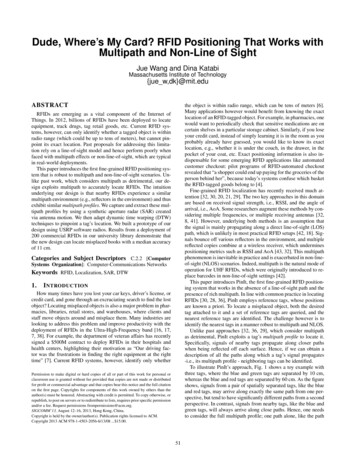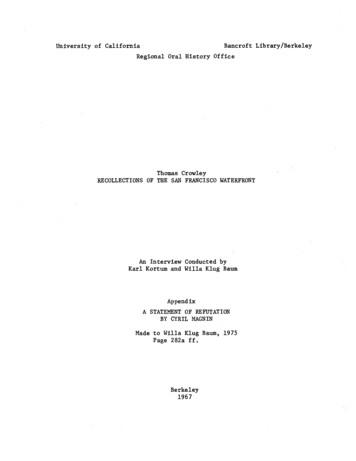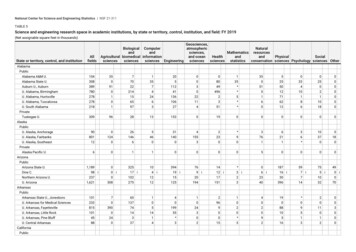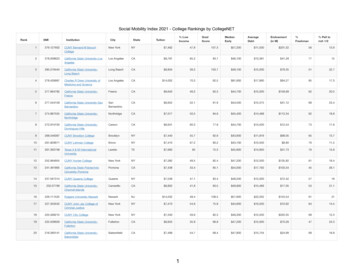
Transcription
5/5/2008An automatic method, relying on storing and remotelyretrieving data using devices called RFID tags ortranspondersyDiane BraymanRaul CalienesCasey DavidsonReed McCalmonMegan MillsHistory of RFIDsBegan in WWll50s, 60s, 70s developing80s toll booth RFIDs1999 System better suited for supply chain1
5/5/2008What is Automatic Identification?Technology to identify object or personTypes:1. Bar codes2. Voice Recognition3 Retinal Scanning3.4. RFIDsHow do they work?Transponders, tagsReaders2
5/5/2008Passive and active tagsPassive tagsActive TagsCostsReaders 500 - 3,000Tags:Active - 10 - 50 or higherPassive - .20 cents - .50 cents or higher3
5/5/2008BENEFITS OF RFIDRFID Technology & Benefits to a BusinessRFID taggingi allowslluniqueiinformationi fi to bebidentified by what product it is attached to,allowing computers and networks to be trackedefficiently4
5/5/2008If you are considering whether or not RFID wouldbe a beneficial application to your business, thefollowing should be taken into account1. Processing speed is essential or could provide a competitiveadvantage2. Bar codes cannot sufficiently survive your manufacturingprocess3. You need more information on an item than a bar code canprovide4. You deal with high-value assets that need to be protected5. SomeSareas off your ffacilitiesili i needd to beb protectedd fromfunauthorized access6. You are a highly automated company, and need to minimizehuman intervention7. It would be beneficial to your company to know locations ofeach product at all times during the supply chainWhat does a business do to adoptRFID technology?There are many benefits gained by assessing internalbusiness processes to determine the priorities,priorities needs,needs andcapabilities of your company.Whether your business adopts RFID technologyimmediately, or at some point in the future, your businesswill gain a competitive advantageIn order to go about implementing RFID, business’ shouldtake a needs-focused analysis of their business processes,their systems architecture, and their internal capabilities5
5/5/2008Steps to Implement RFID Technology1. Assess your EPC numbering options2 Assess management of your RFID readers &2.devices3. Assess management of your data4. Assess integration of your business applications5. Assess integration with your trading partners6 Assess management of your processes6.7. Assess your scaling capabilities & management ofarchitectureONCE YOU HAVE COMPLETEDTHE ASSESSMENT PROCESS,YOU SHOULD BE MUCH MOREORGANIZED AND ON YOURWAY TO IMPLEMENT RFIDTECHNOLOGY INTO YOURBUSINESS6
5/5/2008OTHER BENEFITS OF RFIDAsset TrackingOne of the most common applications for RFID.Placing RFID transponders on or in high-valuehigh al e assetsand returnable transport containers enablescompanies to gather data on their location quicklyand with little or no manual intervention. Taggingassets allows companies to increase asset utilization,identify the last known user of assets,assets automatemaintenance routines and reduce lost items.NYK LogisticsAir Canada7
5/5/2008Could RFID benefit the consumer?Cost cuts for the retailer can almostalways relay to cheaper goodsespecially if you look at all the ways theretailers are saving:Reduced inventory through a one-time cash savingsestimated at 5 percent of total inventoryAn annual benefit from a reduction in store andwarehouse labor expensespof 7.5 percentpWith a reduction in out-of-stock inventory there willbe a recurring annual benefit of 700,000 per 1billion in annual sales for retailers who reengineertheir current shelf fulfillment processesConsumer vs. Retailer cost changeClearly with all these cost cuts across the board for theretailers theyy see a feasible pprofit increaseWith our highly competitive markets there is no reasonwhy the consumer would not benefit from such cost cuts,not to mention all the other possible uses for such anadvanced technology8
5/5/2008Other RFID consumer benefitsRFID is recently being researched to assist people withAlzheimer'ss disease or other cognitive impairmentsAlzheimerIt can also help with increasing speed on recalls forproducts such as meat and other food productsThe future could also hold such items like tagging food sothat when you put it in your microwave it knows by its RFIDg exactlyy how longg to cook it for or yourywasher knowstagexactly how to wash what clothes you put inRaising pricesThe only price increase for consumers couldcome from the involved costs to retailerstransferring to an RFID systemIn the long run the numbers add up to showbenefits for both consumer and retailers soit is just the initial startup fees that couldcreate a price jump for certain itemsOnce the major companies all get onboard the entrance costs will decreaseallowing the technology to be moreprevalent in many markets9
5/5/2008DISADVANTAGES OF RFIDCost of ImplementationHigh switching costs Costof chips Cost of equipment Testing Training Maintenance10
5/5/2008RFID Cost EstimateInvestment AreaRFID TagsNo. of UnitsCost Per Unit (USD)Total Cost (USD)10,000,000 .15 1,500,000.00RFID Readers100 8,000.00 800,000.00RFID Printers100 3,000.00 300,000.00Edge Servers50 2,500.00RFID MiddlewareN.A. 125,000.00 200,000.00RFID ConsultingN.A. 128,000.00RFID TrainingN.A.Variable CostTag ValidationN.A. 80,000.00Total Cost 3,133,000.00Zhang, Qingyu. E-Supply Chain Technologies and Management. Hershey, PA: Information Science Reference,2007. 112-141.Security/Privacy ConcernsSpy on data transmissionsData tamperingFrequency JammersPhysical Location KillTag or Blocker Tag ApproachCustomer Tracking BuyerPrice ManipulationGarfinkel, Simson. RFID Applications, Security, and Privacy. Upper Saddle River, NJ: AddisonWesley, 2006.11
5/5/2008Usage InefficienciesObstruction Errors\Interference LargeLpalliatesllioff RFIDRFID, possibleibl to missi tag Limited transmission through metal or moist surfacesCollusion of different RFID tags when scanned bythe tag reader Preplannedobject movementDifference of RFID tags\readers between vendors RFIDTag StandardSabri, Ehap H., and Arun P. Gupta. Purchase Order Management Best Practices: Process, Technology, andChange Management. Fort Lauderdale, FL: J. Ross, 2007.With all the pros and cons weighed out there are obviousreasons why this technology will be seen more and more inthe futureThe skeptics are afraid of us all becoming “bar-coded” andthe majority of them don’t know enough to judge whether itis beneficial or notRFID is ggoingg to cut costs for everyoneyand make utilizinggthis new technology beneficial for all who partake12
L lli f RFID ibl i Large palliates of RFID, possible to miss tag Limited transmission throug h metal or moist surfaces Collusion of different RFID tags when scanned by the tag reader Preplanned object movement Difference of RFID tags\readers between vendors RFID Tag Standard Sabri, Ehap H., and Arun P. Gupta.










